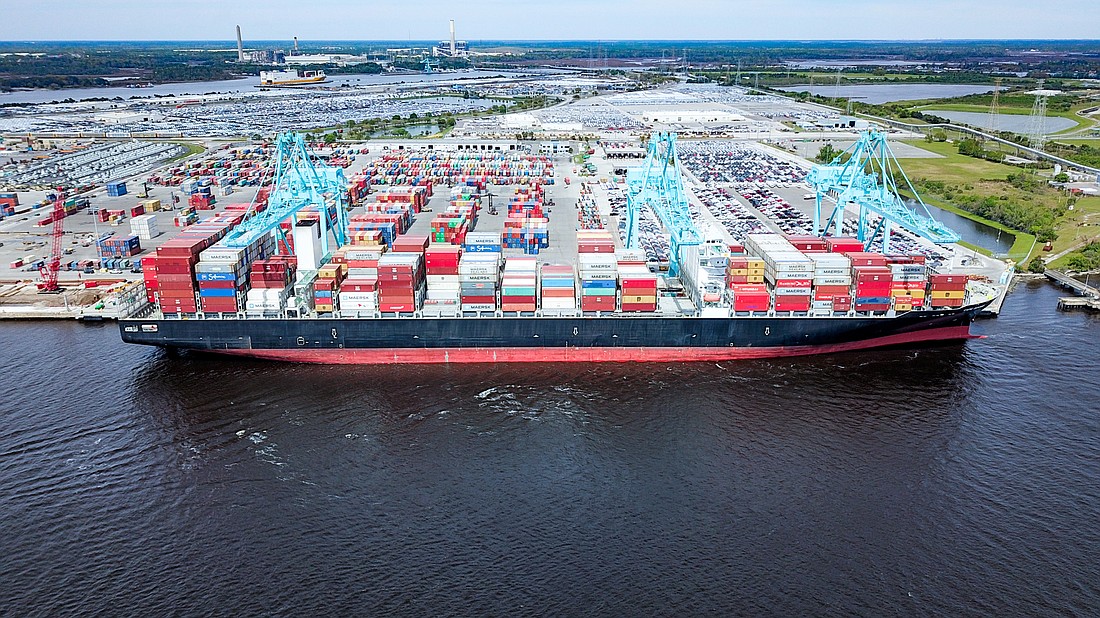
In 2008, the Jacksonville Port Authority’s top cargo container trading partner, by far, was Puerto Rico.
JaxPort saw 71% of its 697,000 cargo units coming from or heading to the United States territory. The remainder of its container business came primarily from South American countries.
“At that time, (JaxPort) had no direct service to Asia. You had to go through another port,” said Robert Peek, the port’s director of marketing and general manager of business development.
To grow, JPA officials saw the need to begin a program to diversify its trading partners, which sparked a pivot to Asia.
Today, Puerto Rico makes up 56% of JaxPort’s total container business but Asian markets are gaining.
In JPA’s annual state of the authority presentation Monday to Jacksonville City Council at the JaxPort cruise terminal, officials showed how diversification has resulted in a more than 100% increase of Asian cargo in and out of Jacksonville since 2012.
The growth in Asian markets has contributed to JaxPort’s status as Florida’s top container port, now moving more than 1.27 million cargo units through the port every year, according to figures from JPA.
Six of JaxPort’s top 10 trading partners are Asian nations — Vietnam, Thailand, Japan, South Korea and Malaysia. China is No. 2.
Despite the increase in Chinese trade, Peek says JPA does not anticipate U.S. trade tensions with China affecting container volume coming through the port.
U.S. tariffs on $200 billion in Chinese goods entering the country have caused China to retaliate with $60 billion in tariffs on U.S. products beginning in June.
Part of the push to diversify markets, Peek said, “was to insulate us from (economic) shock or downturn in any one country. We continue to diversify and we’re pleased with our progress,” Peek said. “We see these tariff increases, case in point.”
Container shipping accounted for 50%, or almost $15.5 million, of the port’s cargo revenue in fiscal year 2018. About 8% to 9% — between $1.24 and $1.4 million — of JaxPort’s total container volume comes from Chinese imports and U.S. exports to China.
Nearly 5,000 products are affected by China’s retaliatory tariffs.
JaxPort is a point of entry for many of the Chinese imported consumer goods affected — mostly items found at big-box retailers, Peek said, like consumer electronics, toys, clothing and furniture.
Peek said any impact on JaxPort’s bottom line will depend on the reaction from customers.
That response is uncertain. Peek said goods that were in route from China when the new tariffs were instituted Friday were not subject to the additional tax, and it’s unclear how long the tariffs will last.
Lake Ray, executive director of the First Coast Manufacturers Association trade group, remains optimistic that the Trump administration’s tariff trade dispute with China will make American-made goods more competitive long-term in world markets.
“I’m not sure what it’s going to do in terms of overall projects. Prices might be impacted in the short term, but in the long term, I think they’ll start to balance out,” he said.
Ray’s association represents the interests of area manufacturers and most purchase raw materials produced overseas to make their products.
Prices that U.S. manufacturers were paying for imported Chinese raw steel spiked when the Trump administration instituted a 25% tariff. This will be expanded in June to include imported steel from Mexico, Canada and the European Union.
Ray doesn’t predict many Jacksonville-area businesses changing their practices because of the tariffs. He said companies like Metal Container Corp., which produces aluminum cans for Anheuser-Busch, PepsiCo and others, have seen production costs rise.
Ray said businesses that locked in raw material prices before the tariffs with long-term contracts are protected, but some contracts would be redrafted as the tariffs linger.
“It’s about the long game,” Ray said. “We’re moving toward a good space. We’re going to have some pain in the short term to get there.”